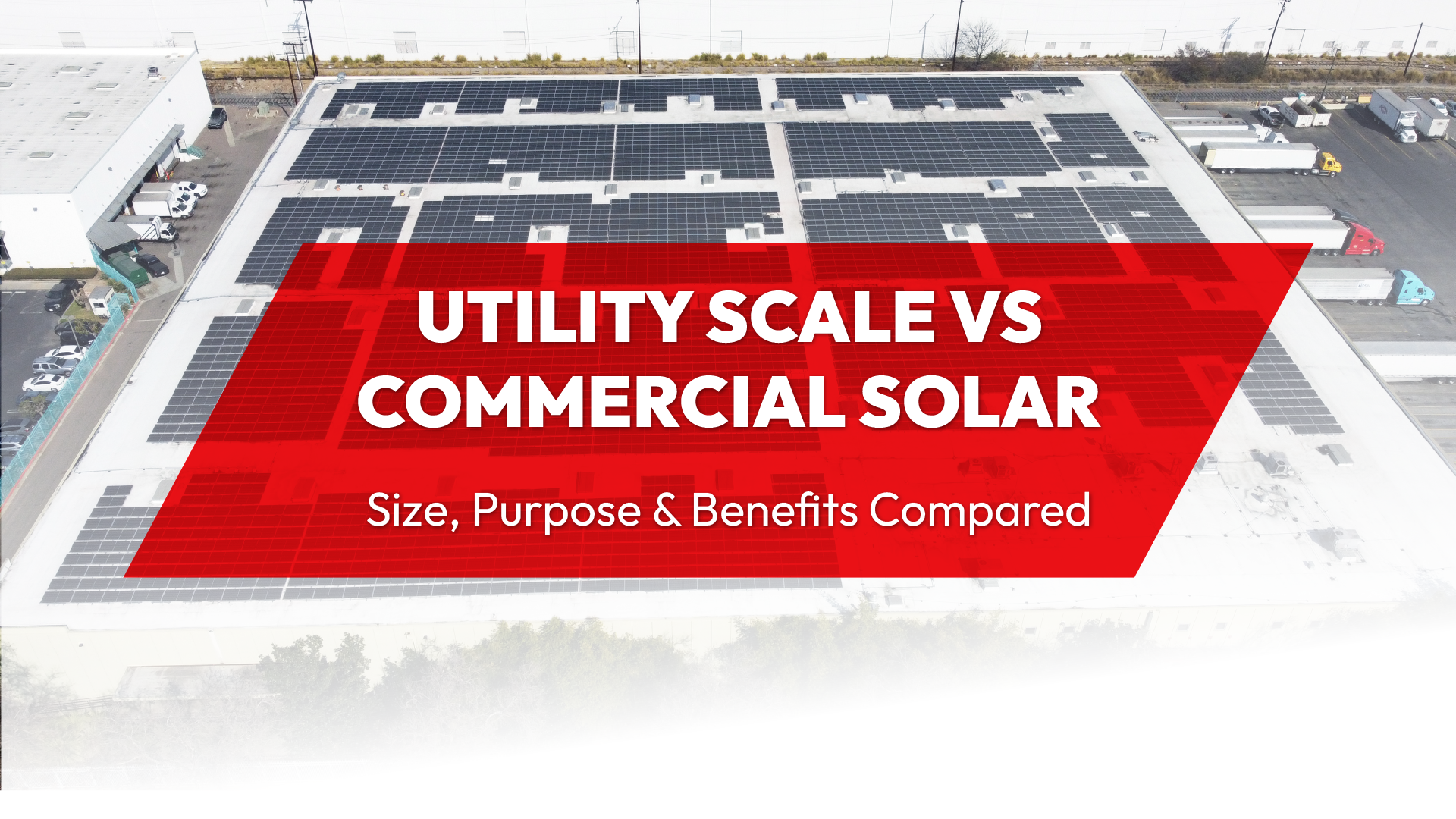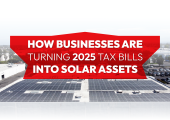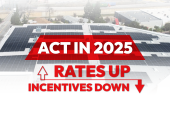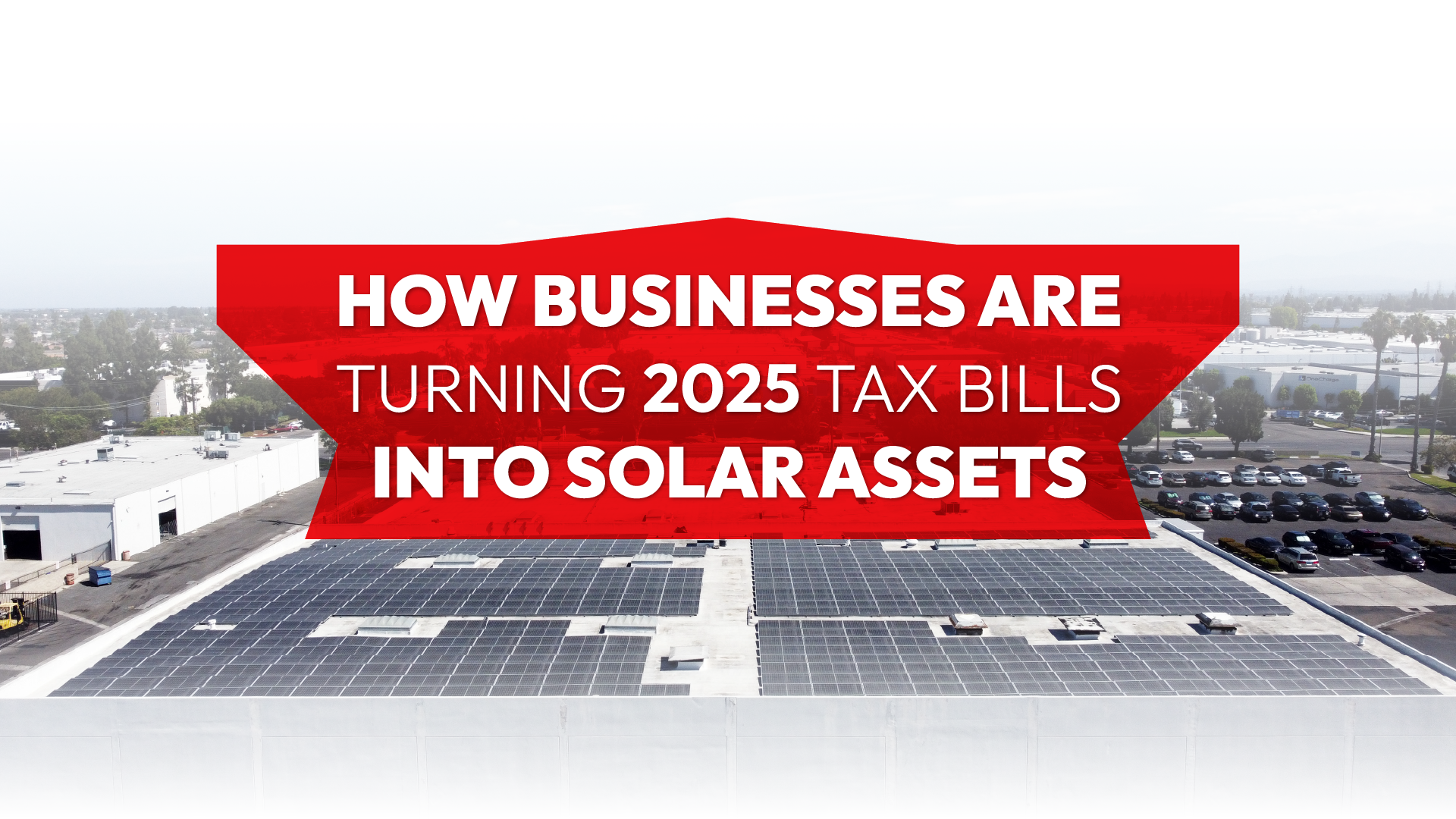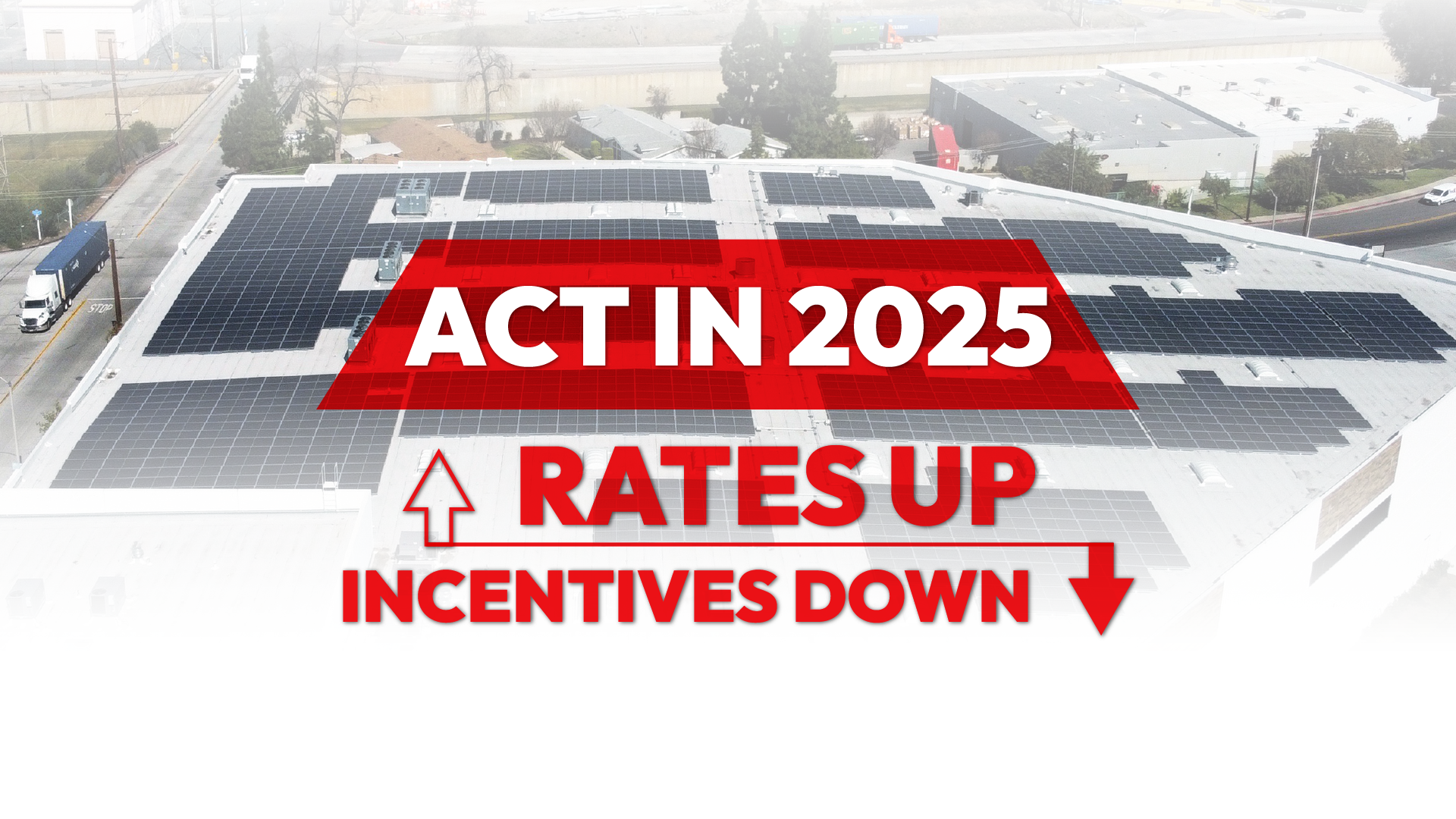What’s the best solar investment for your organization—utility-scale or commercial solar?
While both models harness the power of the sun, their applications, scale, costs, and benefits vary widely.
In this guide, we explore the distinctions between these two solar solutions and how they align with different energy goals, environmental initiatives, and business strategies.
What Is Utility-Scale Solar?
Let’s start by examining the larger of the two: utility-scale solar.
Utility-scale solar is large-scale solar energy systems that generate electricity to be distributed through the electric grid. These installations are designed to serve utilities or wholesale buyers of electricity, rather than specific end-users. Commonly known as solar power plants, these systems are built and maintained by energy companies, utility companies, or large-scale solar developers.
Characteristics of Utility-Scale Solar Projects
- Size and Scope: Utility-scale solar installations typically range from 1 megawatt (MW) to several hundred megawatts. These massive systems often cover hundreds or even thousands of acres of land. In the U.S., the utility‑scale segment installed a record 41.4 GWdc in 2024—marking a 33% annual growth
- Energy Distribution: The electricity produced by these systems is not consumed onsite but instead fed into the distribution grid to meet regional or national energy demands. This makes them integral to the structure of integrated electricity markets.
- Development and Approval: Utility-scale solar projects require extensive planning and regulatory compliance. The center site selection process involves analyzing solar irradiance, access to transmission lines, land ownership, and environmental impact. Permits from federal and state agencies, such as the Federal Energy Regulatory Commission (FERC), are often required. Projects often span 2 to 5 years, with up to 3 years spent in permitting and interconnection.
- Advanced Technology and Integration: These systems may include energy storage systems to manage supply during peak demand or adverse weather conditions. The use of battery banks and smart grid integration helps ensure a stable and reliable source of electricity.
- Environmental Benefits: Utility-scale solar projects significantly reduce carbon emissions and contribute to a clean electricity supply, supporting public policy goals related to climate change mitigation. Each acre of solar panels replacing fossil fuels can avoid 175–198 metric tons of CO₂ annually—over 200× the sequestration capacity of acre-for-acre forest.
What Is Commercial Solar?
While utility-scale solar powers regions, commercial solar brings energy savings and autonomy directly to business operations.
Commercial solar refers to solar energy systems installed on commercial properties such as office buildings, warehouses, industrial facilities, and agricultural land. These systems are designed to provide power directly to the business or organization occupying the site.
Characteristics of Commercial Solar Installations
- Installation Size: Commercial solar systems are larger than residential systems but smaller than utility-scale systems. Usually 10 kW to several MW. U.S. commercial deployments are expected to grow ~8% in 2024
- Onsite Energy Use: The primary purpose of commercial solar is to reduce a company’s reliance on the utility grid and lower utility costs. Many systems are designed with net metering in mind, allowing businesses to send excess power back to the grid in exchange for credits.
- Project Development: The design process for commercial solar projects involves a detailed analysis of a company’s energy usage, roof space, and local regulations. Financial modeling includes calculations around return on investment considerations, additional costs, and installation costs.
- Business Benefits: Businesses enjoy improved energy efficiency, reduced utility costs, tax advantages, and a stronger brand reputation through visible commitments to sustainability.
- Flexibility and Speed: Commercial installations can be completed in as little as a few months, offering faster deployment and reduced financial risk compared to utility-scale projects.
Utility vs Commercial Solar: Side-by-Side Comparison
To clarify these distinctions further, let’s compare utility-scale and commercial solar across a variety of key factors.
Understanding the differences between utility and commercial solar helps stakeholders determine which system best suits their needs. Here is a breakdown across key dimensions:
|
Feature |
Utility-Scale Solar |
Commercial Solar |
|
Primary Use |
Feeds into the electric grid for public use |
Onsite electricity for business systems |
|
Location |
Public lands, deserts, large parcels |
Office buildings, rooftops, land owned by businesses |
|
Project Size |
1 MW to 500+ MW |
10 kW to several MW |
|
Energy Sale |
Sold to grid or utility company |
Used on-site; excess sent to grid |
|
Development Time |
2 to 5 years |
3 to 12 months |
|
Financial Risk |
Higher due to market volatility, basis risk |
Lower, quicker ROI |
|
Permitting |
Complex, requires multiple agency approvals |
Local permits and utility coordination |
|
Business Models |
Power purchase agreements, public-private partnerships |
Direct ownership or lease models |
|
Technology |
High-capacity panels, energy storage systems |
Rooftop Solar, moderate-scale systems |
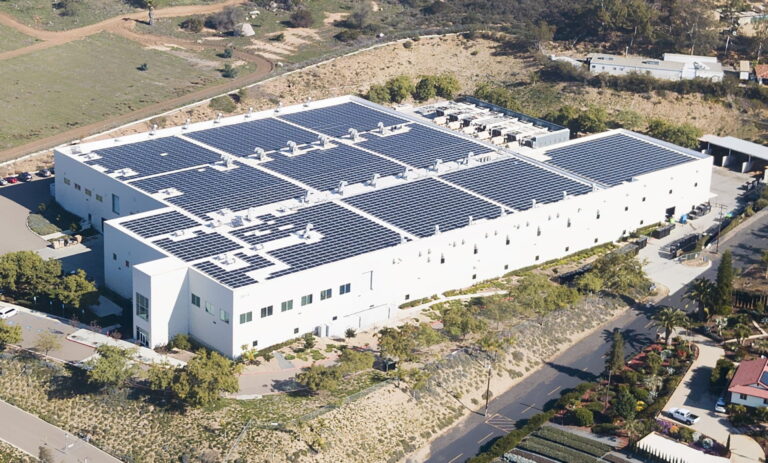
Why It Matters: Business and Environmental Benefits
Now that we’ve laid out the core differences, it’s important to understand why they matter for economic performance, sustainability outcomes, and strategic energy use.
Economic Benefits
- Cost Savings: Solar energy reduces long-term electricity costs—U.S. solar capacity grew from 314 MW (1990) to 91,309 MW by the end 2023.
- Public and Private Investment: Tax credits (like ITC) and grants support both scales; annual solar deployment has grown ~28% per year in the last decade
- Increased Property Value: Commercial buildings with solar often experience higher resale values and lower operating costs.
Environmental Benefits
- Carbon Emissions Reduction: Solar energy systems produce clean electricity and help reduce reliance on fossil fuels.
- Improved Air Quality: Transitioning to renewable sources like solar reduces pollution and contributes to healthier communities.
- Lower Carbon Footprint: Solar systems contribute to company-wide and national carbon footprint reduction goals.
Strategic Energy Planning
- Grid Resilience: Utility-scale solar improves grid capacity and reduces dependency on centralized generation sources.
- Energy Independence: Commercial systems provide energy independence for businesses and protect against rising electricity costs.
- Support for Electric Vehicles: Solar installations can be paired with EV charging stations to meet growing transportation demands.
The Role of Solar in a Diversified Energy Strategy
To truly future-proof our energy systems, a mix of solar strategies is essential.
The American solar market includes a wide range of participants, from utility-scale developers and industrial operators to individual homeowners and community programs. Each plays a role in meeting renewable energy goals.
- Residential Systems: Solar home systems help private homes cut costs and become more energy efficient.
- Commercial Installations: Provide direct benefits to business owners and support broader climate goals.
- Utility-Scale Systems: Drive the largest gains in energy supply and economic scale.
As electricity costs fluctuate and extreme weather events increase, a balanced portfolio of solar assets provides greater stability. Clean energy future goals are only achievable when residential, commercial, and utility systems work together.
Preparing for the Future: Skilled Talent and Scalable Solutions
Behind every successful solar installation is a team of trained professionals.
The solar industry continues to expand, and with it, the need for a skilled and specialized workforce. Programs in advanced utility-scale solar training and certifications in utility-scale solar engineering are preparing a new generation of industry professionals. These individuals will lead the way in designing and executing high-capacity solar projects that meet evolving energy usage and grid requirements.
Conclusion
Ultimately, the decision between utility-scale and commercial solar comes down to your energy objectives, available space, and long-term vision.
While both offer a range of benefits, they serve different purposes and stakeholders. Utility-scale systems are foundational to large-scale energy infrastructure, while commercial installations empower businesses to manage energy costs and advance sustainability goals.
Revel Energy stands ready to assist industrial, agricultural, and commercial clients in identifying the right energy solution. From solar development and planning to installation and ongoing optimization, we deliver high-value, sustainable power systems that support your bottom line and a cleaner planet.
Let’s work together to unlock the full potential of solar and build a future powered by renewable energy.
Frequently Asked Questions (FAQ)
Commercial installations generally take less time to complete (3–12 months) compared to utility-scale projects, which often take 2–5 years due to complex permitting and infrastructure requirements.
No. Utility-scale solar requires expansive land areas and cannot be accommodated on rooftops or standard commercial properties. These are best suited for solar farms and large tracts of public or agricultural land.
Utility-scale solar offers a wide range of benefits including high energy output, grid capacity expansion, and substantial reductions in carbon emissions. These projects also contribute to electricity cost stability and clean electricity generation.
Generally, yes. Commercial solar projects have shorter timelines, lower upfront costs, and quicker returns on investment. In contrast, utility-scale systems carry more basis risk and financial risk due to longer development cycles and market variability.
These systems provide significant environmental benefits by displacing fossil fuel-based energy generation, reducing carbon emissions, and supporting national climate targets. However, their installation must consider the impact on public lands and biodiversity.
Yes. Both commercial and utility-scale solar can supply power for electric vehicle charging infrastructure, reducing the overall carbon footprint of transportation.
ROOFTOP SOLAR
Commercial grade rooftop solar is ideal for: manufacturing, warehousing, logistics, industrial, retail, hospitality buildings and more with over 10,000 sq. ft. rooftops.
CARPORT SOLAR
Free standing carport solar generates added solar power for properties with limited rooftop space. Added benefits include shading and protection for employees vehicles.
ENERGY STORAGE
Crucial for reducing peak demand charges. Automated to supply electricity when your panels won’t. Energy storage is ideal for businesses that incur significant peak charges.
EV CHARGING STATIONS
As the popularity of EVs increase, so does the demand for on-site EV charging stations. This sustainable amenity has become a parking lot fixture for employers.
CREATING CAPITAL THROUGH SUSTAINABILITY, WE OFFER:
PROFESSIONAL GUIDANCE
CUSTOM TAILORED PLANNING
ENGINEERING, PROCUREMENT, CONSTRUCTION & INSTALLATION
CSLB #1106092
Client Testimonial: Kelemen Company
Corporate Business Park in Irvine, CA has created significant electricity cost savings through commercial solar installed across the 5-building business park.
Client Testimonial: Tice Gardner & Fujimoto LLP
See how this CPA firm saved on electricity and gained valuable tax credits through commercial solar that they used to keep cash in the businesses.

